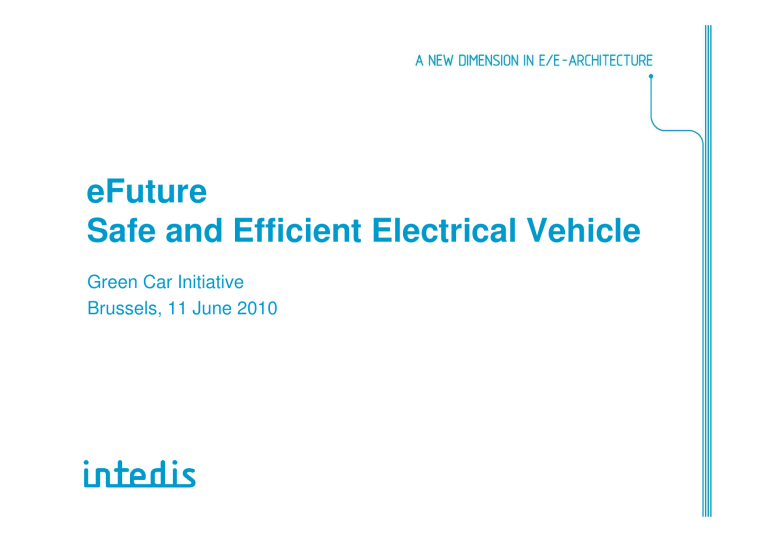
eFuture
Safe and Efficient Electrical Vehicle
Green Car Initiative
Brussels, 11 June 2010
Concept and project objectives
Lots of factors influence the energy fluctuation within a vehicle
A vision at vehicle level is mandatory to get a new lean vehicle architecture
Energy optimised and safe vehicle infrastructure
Drivetrain performance: new actuators, influence by friction, centre of gravity
ADAS performance: complexity of independent systems, time to decision
Choices of dynamics based on: drivetrain current state & energies levels, ADAS &
driver commands, time horizon
energy
buffer
short term
reserve
static part of
infrastructure
long term
reserve
actuators
needs
energy
capacity
dynamic part of
infrastructure
© Intedis GmbH & Co. KG. All rights reserved.
2
Presentation of the consortium
01-INT
Intedis
PIC: 985 994234
Consulting services
Architecture, decision units
http://intedis.com
02-TMETC Tata Motors
PIC: 985 803920
Vehicle manufacturer
Integration, drivetrain control
http://uk.tata.com
03-MIL
Miljøbil Grenland
PIC: 985 882296
Vehicle manufacturer / Tier 1
Batteries, Energy Management
http://www.miljobil.no
04-HELLA Hella
PIC: 992 440078
Tier 1
Sensors, ECUs
http://www.hella.com
05-INRETS INRETS-Livic
PIC: 999 612064
Research center
Dynamics controller
http://www.inrets.fr/ur/livic
06-WIVW WIVW
PIC: 999 668324
Consulting services
Ergonomics, simulators
http://wivw.com
© Intedis GmbH & Co. KG. All rights reserved.
3
driver’s
inputs
displays
sounds …
eHor.
side
cam.
lidar
front
cam.
Data flow and presentation of the work packages
data
fusion
(WP610, 28PM)
driver
monitoring
(WP630, 12PM)
manoeuvre
recognition
feedback
management
(WP640, 2PM)
decision unit
at the command layer
(WP650, 9PM)
-switch stability
-support definition
-motion control
vehicle controllability
(WP620, 18PM)
(WP640, 22PM)
motion optimisation criteria
decision unit
at the execution layer
vehicle
observer
manoeuvre
controllers
-switch stability
-control definition
-vehicle dynamics control
energy
management
drivetrain
controller
battery +
monitoring
electric
motors
(WP420, 33PM)
steering unit
(WP410, 8PM)
(WP440, 33PM)
© Intedis GmbH & Co. KG. All rights reserved.
(WP430, 24PM)
4
S/T methodology and description of the work packages
Four pillars for the project
WP 100 – Project management (MGT)
WP 200 – Vehicle specification (RTD)
WP 300 – Vehicle integration & validation (DEM)
WP 400/500/600 – Development of the layers (RTD)
WP 200
Scenarios
definitions
Functional
requirements
Components
specifications
Components
development
T
IN
WP 300
C
T
E
M
T
Scenarios
validation
Platform
validation
Components
integration
S A TC
T
E LL E
R
IN HE TM
WP 400, 500, 600
© Intedis GmbH & Co. KG. All rights reserved.
5
Vehicle specification
Creation of a virtual prototype to set the prototypes targets
Simulation platforms as backbone for the concept development
Set of vehicle behavior and safety requirements
OpenDrive
WP 210
Scenarios
description
WP 220
Functional
model
WP 230
Architecture
definition
RT Maps
WP 240
Requirements
Funcosar
PathEdit
WP 210 Backbone
•Requirements & Behaviors
•Scenarios Models
•Components & Vehicle models
•Dataflow
TopCad-I
SIVIC
WP 210
Perception
layer design
SIVIC
WP 220
Energy flow
Matlab
WP 220
Dynamics
control
© Intedis GmbH & Co. KG. All rights reserved.
WP 220
Driver
acceptance
SILAB
6
Development and integration
Three development groups in parallel with linear integration
WP 400 – Execution layer: electric motors, traction battery, Dynamics Control
WP 500 – Electronic platform: ECUs and network nodes
WP 600 – Command layer: Sensors, Co-Pilot, Decision Units
Co-Pilot
Configuration
Passive
Prototype
INRETS – WP600
Architecture
Components
2nd
merge
Test
Bench
HELLA – WP500
Driveline
Integration
1st
merge
Driveline on
HiL
TMETC – WP400
prototype 2
UK
prototype 1
GE
TMETC – WP300
© Intedis GmbH & Co. KG. All rights reserved.
7
Execution Layer
Preliminary driveline in three domains (to be worked-out during the requirements phase)
High voltage domain: traction battery, HVAC, inverter & electric motor
Low voltage domain: service battery, DC/DC converter, power steering, brakes
Mechanical domain: integrated transmission, safety clutch, differential
traction battery
HVAC
service battery
DC/DC
invert.
ECU
EPS
ESP
eM
transmission
clutch
Traction battery
Cells & pack: MIL
Sensors & EMS: HELLA
HVAC: TMETC (out of scope)
Inverter & electric motor: TMETC (or new partner)
Clutch & differential: TMETC (not budgeted)
Service battery: INT
EPS, ESP: unchanged (gateway from TMETC)
ECU
HW: HELLA
SW: INT & TMETC
© Intedis GmbH & Co. KG. All rights reserved.
8
Electronic Platform
Hella: ECU
Design and development of the test environment
HW/SW integration and verification in lab
ECU target currently only A-SiL A/B with Autosar A-SiL D possible 2015
INT: Communication platform
Communication matrix, power modes, vehicle diagnostics
Physical layer (Flexray topology, nodes, wake-up)
Conformance tests and failures recognitions
TMETC: Gateways
INT
…
…
INRETS
TMETC
ECU
HELLA
Autosar-like
RTE
EPS
GW
TMETC
INT
HELLA
© Intedis GmbH & Co. KG. All rights reserved.
TMETC
9
Command Layer
Exterioceptive sensors & data fusion
Image processing platform, Lidar, side cameras, eHorizon
Data fusion - perception layer
Virtual co-pilot
Situation assessment
Maneuvers controllers:
Longitudinal control down to vehicle standing
Lateral control with lane keeping and lane changing
Integrated longitudinal and lateral control
Predictive speed adaptation
Driver monitoring: driver's mental model and driver's acceptance
Decision unit
Stability assessment
Maneuver recognition
Transition between actors/maneuvers
Arbitration unit
Driver Interface
Specification of components needed for HMI
Components definition & development
© Intedis GmbH & Co. KG. All rights reserved.
10

